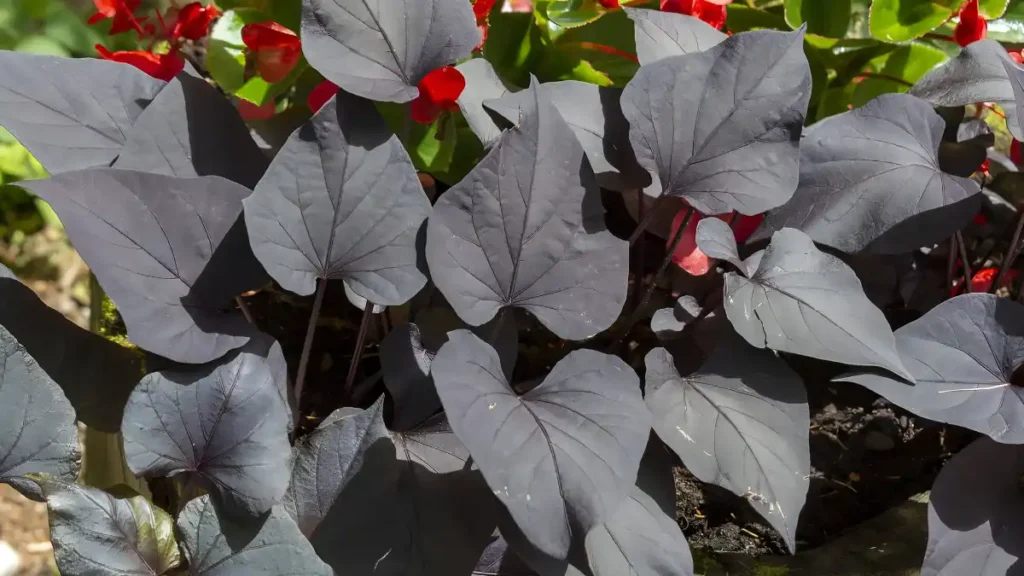A striking tropical plant, the beautiful sweet potato is a perennial in Florida. It is known scientifically as Ipomoea batatas. They’re a popular choice for houseplants because they’re low maintenance and easy to cultivate. Aside from the occasional pruning, decorative sweet potatoes are low-maintenance plants. Although they can tolerate drought and grow in little shade, they like full sun and soil that drains well. Learn more about its development by reading this article through to the end.
Find out how to plant ornamental sweet potatoes:
A few simple gardening tools and careful attention to detail are all needed for planting ornamental sweet potatoes. This extensive guide will assist you in getting started.
How to grow ornamental sweet potato vine:
- Ornamental sweet potatoes are usually planted about 8 inches high in rows to get them started. It facilitates rapid soil heating and effective drainage. Covering the soil with black plastic will allow it to warm up more rapidly if you garden in chilly weather. Plant these tropical plants only in the spring, once the soil has warmed up completely.
- Select an area in your yard that receives full sun and add a pot that is 12 to 18 inches deep. Sow the ornamental sweet potato plant 2 to 3 inches deep in soil that drains well. Place the rows three to four feet apart to allow the vines to spread.
- When planting ornamental sweet potatoes, make sure they are in full sun to partial shade. For optimal foliage color, try to get at least 6 hours of direct sunlight each day. In dry areas, some people prefer midday shadow. Well-drained yet high-organic matter soil is utilized by sweet potatoes.

All about ornamental sweet potato vine care:
You may appreciate the vibrant and thick foliage of decorative sweet potato plants in your yard or house by paying attention to these care tips.
- Once acclimated to dry soil, sweet potatoes can withstand growing there. It’s ideal to give it one inch of water once a week to keep it evenly moist but not soggy. Before watering potted plants, let the top inch of soil dry off.
- Although they don’t require a lot of food, ornamental sweet potatoes do benefit from a balanced diet, which is usually achieved with good soil preparation. Throughout the growing season, feed the plants every four to six weeks using a balanced, water-soluble fertilizer. An organic liquid fertilizer can also be added to the soil before planting.
- Sweet potato vines have a rambling growth habit, but they are vital for providing nourishment for the potatoes, so don’t clip them. Trimming overgrown vines can help them keep their structure and promote bushy growth if they are going out of hand. To maintain plant health, remove any yellowed or dead leaves.
- Cuttings of these plants are an easy way to reproduce them. Before the first fall frost, carefully dig up the tubers using a shovel. Over the winter, store them in a sturdy cardboard box packed with dry materials such as vermiculite. Within the box, the tubers shouldn’t come into contact. Store the package somewhere dark and cool. After the tubers start to sprout and the earth has warmed to a minimum of sixty degrees Fahrenheit, divide the cuttings and plant them in the garden.
- The two major issues with cultivating decorative ornamental sweet potatoes in home gardens are wireworms and root-knot nematodes. Aphids, spider mites, and whiteflies are among the pests to keep an eye out for. Neem oil or insecticidal soap are effective treatments for infestations. Avoid watering from above to prevent fungal illnesses.
Conclusion:
In conclusion, ornamental sweet potatoes are popular due to their rapid growth, drought tolerance, and ability to thrive in a variety of soil types, making them ideal for ground covers, container gardens, and hanging baskets. Since attractive forms of these plants frequently produce little, inedible roots and can become invasive if left unchecked, they are not usually planted for their tubers. Gardeners love ornamental sweet potatoes because of their low maintenance requirements and versatility.
Certainly! If you’d like to learn more, please consider following our WhatsApp Channel: Harvest Gardening
A frequently asked questions:
Q1. How to propagate ornamental sweet potato vine?
A1. Usually in the late spring or early summer, remove the lower leaves from a healthy vine, cut the vine into 4-6 inch pieces, and soak them in water or soil to encourage the growth of roots. Until the cuttings take root, keep them in bright, indirect light.
Q2. Why are ornamental sweet potato vine leaves turning yellow?
A2. A shortage of vital nutrients or excessive watering might result in yellow leaves on decorative sweet potato vines. Other contributing factors include inadequate sunlight.
Q3. Is ornamental sweet potato vine poisonous to dogs?
A3. Dogs are indeed poisoned by ornamental sweet potato vines. The plant can induce diarrhea, vomiting, and other gastrointestinal problems when consumed.
Q4. What are some common varieties of ornamental sweet potatoes?
A4. ‘Blackie,’ with dark purple leaves, ‘Margarita,’ with vivid chartreuse foliage, and ‘Tricolor,’ with a combination of green, pink, and white leaves, are common types of ornamental sweet potatoes.



